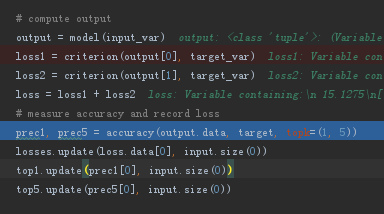mhwu
September 28, 2017, 3:52am
1
In the Inception model, in addition to final softmax classifier, there are a few auxiliary classifiers to overcome the vanishing gradient problem.
My question is
How can I compute the loss with all the classifiers? Can anyone give me an example?
output, aux_output = models.inception_v3(input)
loss = criterion(output, aux_output, target_var)
loss.backward()
optimizer.step()
or
output, aux_output = models.inception_v3(input)
loss1 = criterion(output, target_var)
loss2 = criterion(aux_output, target_var)
loss = loss1 + loss2
loss.backward()
optimizer.step()
2 Likes
smth
September 28, 2017, 3:56am
2
your second code snippet is the way to go.
2 Likes
smth
September 28, 2017, 3:57am
3
usually one of the losses is weighted lower. So you can do:
loss = loss1 + 0.4 * loss2 # 0.4 is weight for auxillary classifier
5 Likes
mhwu
September 28, 2017, 3:59am
4
thank you soooooo much!!!
micklexqg
September 28, 2017, 7:22am
5
thanks for giving the loss. but how to get the final predict with the two output(output and aux_output)? I need to compute the accuracy.
2 Likes
mhwu
September 28, 2017, 7:42am
6
the loss of auxiliary classifiers is used to overcome the vanishing gradient problem and it has nothing to do with prediction. the prediction is made by the final classifier.
micklexqg
September 28, 2017, 7:52am
7
but how to get the prediction made by the final classfier, is it ‘output, aux_output = models.inception_v3(input)’ as you stated in the above.
micklexqg
September 28, 2017, 8:28am
8
any idea for getting the prediction?
mhwu
October 1, 2017, 3:02am
9
def forward(self, x):
...
return(output0, output1, output2)
output0, output1, output2 = model(inputs)
_, preds = torch.max(output2.data, 1)
loss0 = criterion(output0, labels)
loss1 = criterion(output1, labels)
loss2 = criterion(output2, labels)
loss = loss2 + 0.3 * loss0 + 0.3 * loss1
loss.backward()
optimizer.step()
output2 is the prediction of the final classifier, and the other two outputs are the ones of auxiliary classifiers. The overall
As you can see, I made predictions through the output2 .
“At inference time, these auxiliary networks are discarded.” as the paper said.
1 Like
micklexqg
October 6, 2017, 12:03pm
10
helpful code and hint, thank you!
@micklexqg : I followed this, added to the imagenet example script to run on my own data over googlenet (from vision/models/googlenet.py).
Imagenet script organization:
def main()
def main_worker()
def train()
outputs, aux_outputs = model(inputs)
loss1 = criterion(outputs, target)
loss2 = criterion(aux_outputs, target)
loss = loss1 + 0.4*loss2
def validate()
outputs = model(inputs)
loss = criterion(outputs, target)
def adjust_learning_rate()
def accuracy()
Then the execution throws this error:
Traceback (most recent call last):
File "imagenet.py", line 406, in <module>
main()
File "imagenet.py", line 113, in main
main_worker(args.gpu, ngpus_per_node, args)
File "imagenet.py", line 239, in main_worker
train(train_loader, model, criterion, optimizer, epoch, args)
File "imagenet.py", line 279, in train
output, aux_outputs = model(input)
ValueError: too many values to unpack (expected 2)
any idea?
ztleap
March 27, 2019, 5:10pm
12
if model() is GoogleNet.forward(), you need to make sure GoogleNet.aux_logits=True. Otherwise it would just return output, rather than (output, aux_outputs). Giving you that error.
1 Like
I figured out that, GooLeNet has two auxoutputs, and worked by these modifications. So,
aux1, aux2, outputs = model(inputs)
loss1 = criterion(aux1, target)
loss2 = criterion(aux2, target)
loss3 = criterion(outputs, target)
loss = loss3 + 0.3 * (loss1+loss2)
